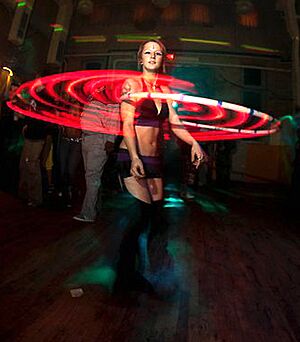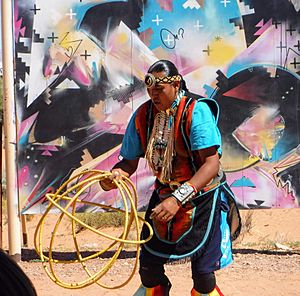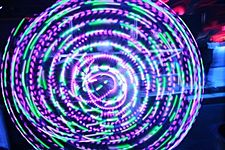Hooping facts for kids
Hooping, also known as hula hooping or hoop dance, is a fun activity where you move and dance with one or more hoops. It's not just about spinning a hoop around your waist! Modern hoopers use bigger, heavier hoops. They can spin them around their hips, chest, neck, shoulders, arms, and even their feet. You can also do cool tricks with the hoop off your body.
Hooping mixes dance moves with special tricks. It's often done with music. This art form has been inspired by things like rhythmic gymnastics, hip-hop, and other dance styles. Hooping is a physical activity that helps you move your body in creative ways. It's sometimes seen as a type of juggling. People who do hoop dance often call themselves "hoopers."
Contents
What is a Hooping Hoop?
Hoopers usually use hoops made from special plastic tubes called HDPE or polypropylene. They often wrap these hoops with colorful tape. This tape makes the hoop look cool and also helps you grip it better. These modern hoops are different from the light plastic toy hoops you might see for kids.
The heavier weight of these hoops helps you control them better around your body. Their larger size also makes them spin slower. This makes it easier to learn new tricks, like stepping through the hoop while it's still spinning. Kids' hoops are usually very light and small. This makes them hard for adults to use.
Circus performers who use hoops, like Elena Lev, used to use light hoops made of aluminum or wood. Today, many circus hoopers use lightweight plastics like polypropylene.
Choosing Your Hoop Size
When you start hooping, adults usually begin with a hoop about 38 to 44 inches wide. These hoops might seem big compared to toy hoops. But they help you learn the skill quickly. As you get better, you can use smaller hoops. Advanced hoopers often use hoops between 30 and 36 inches wide.
There are even very small hoops, sometimes 18 inches wide or less. These are called mini hoops. Only very skilled hoopers use them.
Making Your Own Hoop
Many hoopers like to make their own hoops. They use different types of plastic tubing. The size and weight of your hoop can change your hooping style. Heavier, larger hoops are good for slow moves and tricks around your body. Lighter, thinner hoops are better for quick hand tricks.
Hoops can be covered in fabric or plastic tape. This makes them colorful and easier to keep spinning. Some hoops even glow in the dark or have glitter inside. Others are clear and filled with plastic balls or water. This creates cool visual or sound effects when you use them.
Some hoops can be taken apart into pieces. This makes them easy to carry around. Other hoops can be twisted down and folded in half for storage.
Types of Hooping
Besides regular hoops, hoopers also use special types of hoops. These include fire hoops and LED or glow hoops.
Fire Hooping
A fire hoop has several spokes sticking out from it. These spokes are usually 6 to 8 inches long. Each spoke has a roll of cotton and Kevlar material at the end. This material can be lit on fire. This design keeps the flames a safe distance from the hooper's body.
Using fire always has risks. The way fire hoops are built and their weight can limit the tricks you can do. However, some newer fire hoops are lighter. They have smaller tubes and flexible wick spokes. This allows hoopers to do more tricks with them.
LED Hooping
LED hooping uses hoops that are clear or see-through. These hoops have many small LED lights inside the tube. LED hoops have batteries inside to power the lights.
These hoops are a bit heavier than regular hoops. But they are usually lighter than fire hoops.
There are many kinds of LED hoops. Some have different colored lights. Others can be programmed with a microchip. This lets them create cool patterns as they spin. The lights change color very quickly. This creates images or shapes because of how our eyes see things. Some even have motion sensors. These sensors make the lights react to how you move the hoop.
LED hoops usually don't have grip tape. This is because the tape would block the lights. Instead, the hoop's surface might be sanded. Or a thin strip of grip tape might be placed on the inside of the hoop for better grip.
Hooping for Fitness
In recent years, hooping has become popular as a way to get fit. It's like kickboxing or belly dancing for exercise. You can find hoop dance classes in gyms. Hooping is often combined with Pilates or yoga. These activities help build strength, balance, and flexibility.
Hooping is a type of aerobic exercise. This means it's good for your heart and helps you burn calories. A study found that a 30-minute hooping workout can burn about 200 calories. Hooping uses many muscles in your body. It can help make your core muscles strong. It also improves your flexibility and balance.
Hooping World Records
People have set many amazing world records with hooping!
Longest Hooping Time
The record for the longest continuous hula hooping was held for 10 years by Aaron Hibbs. He kept a hoop spinning for 74 hours and 54 minutes in 2009. But in 2019, Jenny Doan broke that record. She hula-hooped for an amazing 100 hours in Chicago!
Most Hoops at Once
Marawa Ibrahim holds the record for spinning the most hula hoops at the same time. She spun 200 hoops on November 25, 2015!
Largest Group Hooping
On February 19, 2013, 4,483 people swung hula hoops to dance music. They did this for seven minutes without stopping. This happened at Thammasat University stadium in Thailand. It set a world record for the most people dancing with hula hoops together in one place.
Other Cool Records
The largest hoop ever successfully spun was 5.04 meters (about 16.5 feet) wide. Ashrita Furman from the United States spun it in September 2010.
In 2000, Roman Schedler spun a 53-pound tractor tire for 71 seconds. This happened at a festival in Austria.
In April 2010, 70 hoopers called Team Hooprama hula-hooped a half-marathon. That's 21 kilometers (about 13 miles)! They did this in Nashville, Tennessee. They wanted to raise money and awareness for a group called Hooping for Hope.
In March 2013, the biggest hula hoop workout happened in Scotland. 407 people participated.
Images for kids









